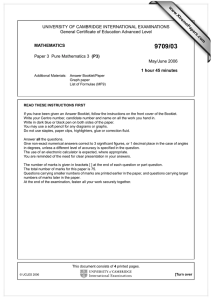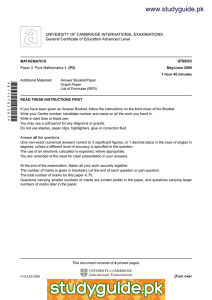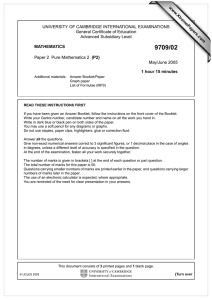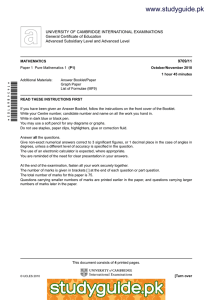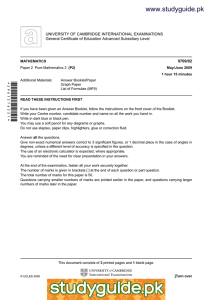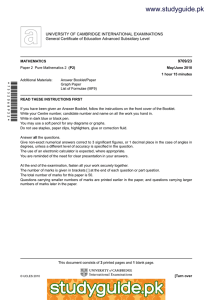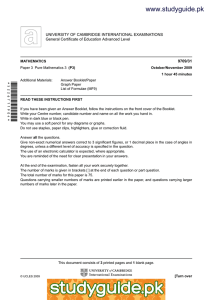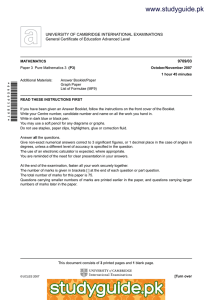*811476 3367* www.XtremePapers.com UNIVERSITY OF CAMBRIDGE INTERNATIONAL EXAMINATIONS
advertisement
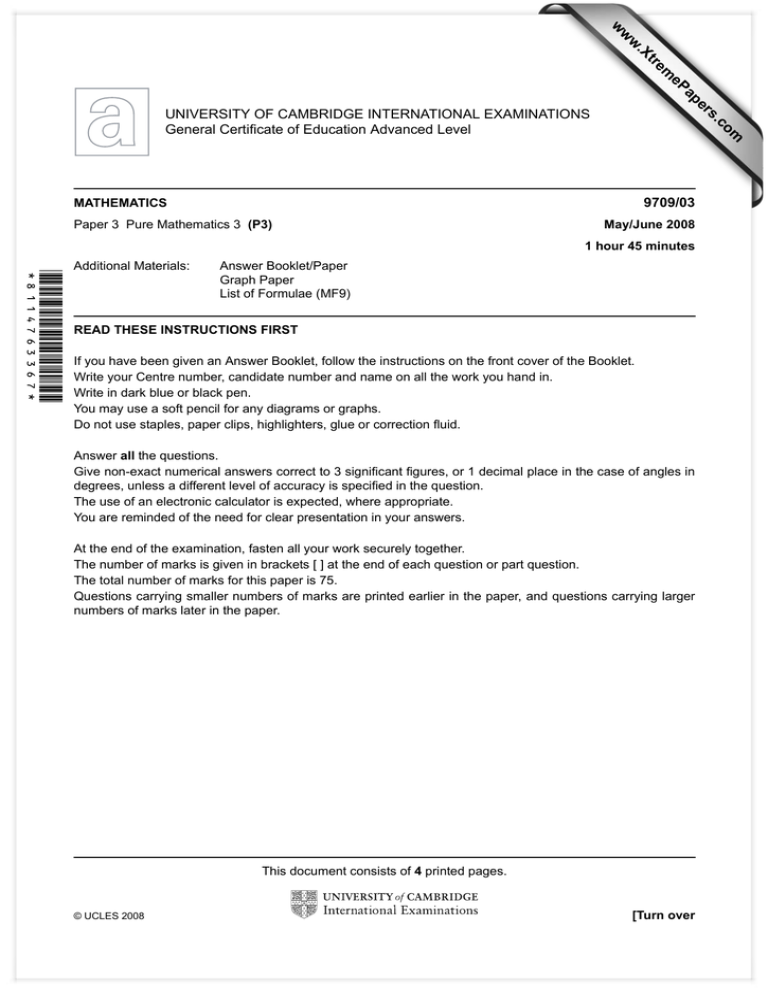
w w ap eP m e tr .X w s er om .c UNIVERSITY OF CAMBRIDGE INTERNATIONAL EXAMINATIONS General Certificate of Education Advanced Level 9709/03 MATHEMATICS Paper 3 Pure Mathematics 3 (P3) May/June 2008 1 hour 45 minutes *8114763367* Additional Materials: Answer Booklet/Paper Graph Paper List of Formulae (MF9) READ THESE INSTRUCTIONS FIRST If you have been given an Answer Booklet, follow the instructions on the front cover of the Booklet. Write your Centre number, candidate number and name on all the work you hand in. Write in dark blue or black pen. You may use a soft pencil for any diagrams or graphs. Do not use staples, paper clips, highlighters, glue or correction fluid. Answer all the questions. Give non-exact numerical answers correct to 3 significant figures, or 1 decimal place in the case of angles in degrees, unless a different level of accuracy is specified in the question. The use of an electronic calculator is expected, where appropriate. You are reminded of the need for clear presentation in your answers. At the end of the examination, fasten all your work securely together. The number of marks is given in brackets [ ] at the end of each question or part question. The total number of marks for this paper is 75. Questions carrying smaller numbers of marks are printed earlier in the paper, and questions carrying larger numbers of marks later in the paper. This document consists of 4 printed pages. © UCLES 2008 [Turn over 2 1 Solve the inequality | x − 2| > 3|2x + 1|. 2 Solve, correct to 3 significant figures, the equation [4] ex + e2x = e3x . 3 N D C r a A [5] x M B 3a In the diagram, ABCD is a rectangle with AB = 3a and AD = a. A circular arc, with centre A and radius r, joins points M and N on AB and CD respectively. The angle MAN is x radians. The perimeter of the sector AMN is equal to half the perimeter of the rectangle. (i) Show that x satisfies the equation sin x = 14 (2 + x). [3] (ii) This equation has only one root in the interval 0 < x < 12 π . Use the iterative formula xn+1 = sin−1 2 + xn 4 , with initial value x1 = 0.8, to determine the root correct to 2 decimal places. Give the result of each iteration to 4 decimal places. [3] 4 (i) Show that the equation tan(30◦ + θ ) = 2 tan(60◦ − θ ) can be written in the form √ tan2 θ + (6 3) tan θ − 5 = 0. [4] (ii) Hence, or otherwise, solve the equation tan(30◦ + θ ) = 2 tan(60◦ − θ ), for 0◦ ≤ θ ≤ 180◦ . © UCLES 2008 [3] 9709/03/M/J/08 3 5 The variable complex number is given by = 2 cos θ + i(1 − 2 sin θ ), where θ takes all values in the interval −π < θ ≤ π . (i) Show that | − i| = 2, for all values of θ . Hence sketch, in an Argand diagram, the locus of the [3] point representing . (ii) Prove that the real part of 1 is constant for −π < θ < π . +2−i [4] 6 The equation of a curve is xy(x + y) = 2a3 , where a is a non-zero constant. Show that there is only one point on the curve at which the tangent is parallel to the x-axis, and find the coordinates of this point. [8] 7 Let f(x) ≡ x2 + 3x + 3 . (x + 1)(x + 3) (i) Express f(x) in partial fractions. [5] 3 (ii) Hence show that f(x) dx = 3 − 12 ln 2. [4] 0 8 y P O T N 1 2p x In the diagram the tangent to a curve at a general point P with coordinates (x, y) meets the x-axis at T . The point N on the x-axis is such that PN is perpendicular to the x-axis. The curve is such that, for all values of x in the interval 0 < x < 12 π , the area of triangle PTN is equal to tan x, where x is in radians. (i) Using the fact that the gradient of the curve at P is dy 1 2 = y cot x. dx 2 PN , show that TN [3] (ii) Given that y = 2 when x = 16 π , solve this differential equation to find the equation of the curve, expressing y in terms of x. [6] © UCLES 2008 9709/03/M/J/08 [Turn over 4 9 y M R x O −1x √ The diagram shows the curve y = e 2 (1 + 2x) and its maximum point M . The shaded region between the curve and the axes is denoted by R. (i) Find the x-coordinate of M . [4] (ii) Find by integration the volume of the solid obtained when R is rotated completely about the x-axis. Give your answer in terms of π and e. [6] 10 The points A and B have position vectors, relative to the origin O, given by −−→ OA = i + 2j + 3k and −−→ OB = 2i + j + 3k. The line l has vector equation r = (1 − 2t)i + (5 + t)j + (2 − t)k. (i) Show that l does not intersect the line passing through A and B. [4] (ii) The point P lies on l and is such that angle PAB is equal to 60◦ . Given that the position vector of P is (1 − 2t)i + (5 + t)j + (2 − t)k, show that 3t2 + 7t + 2 = 0. Hence find the only possible [6] position vector of P. Permission to reproduce items where third-party owned material protected by copyright is included has been sought and cleared where possible. Every reasonable effort has been made by the publisher (UCLES) to trace copyright holders, but if any items requiring clearance have unwittingly been included, the publisher will be pleased to make amends at the earliest possible opportunity. University of Cambridge International Examinations is part of the Cambridge Assessment Group. Cambridge Assessment is the brand name of University of Cambridge Local Examinations Syndicate (UCLES), which is itself a department of the University of Cambridge. © UCLES 2008 9709/03/M/J/08
